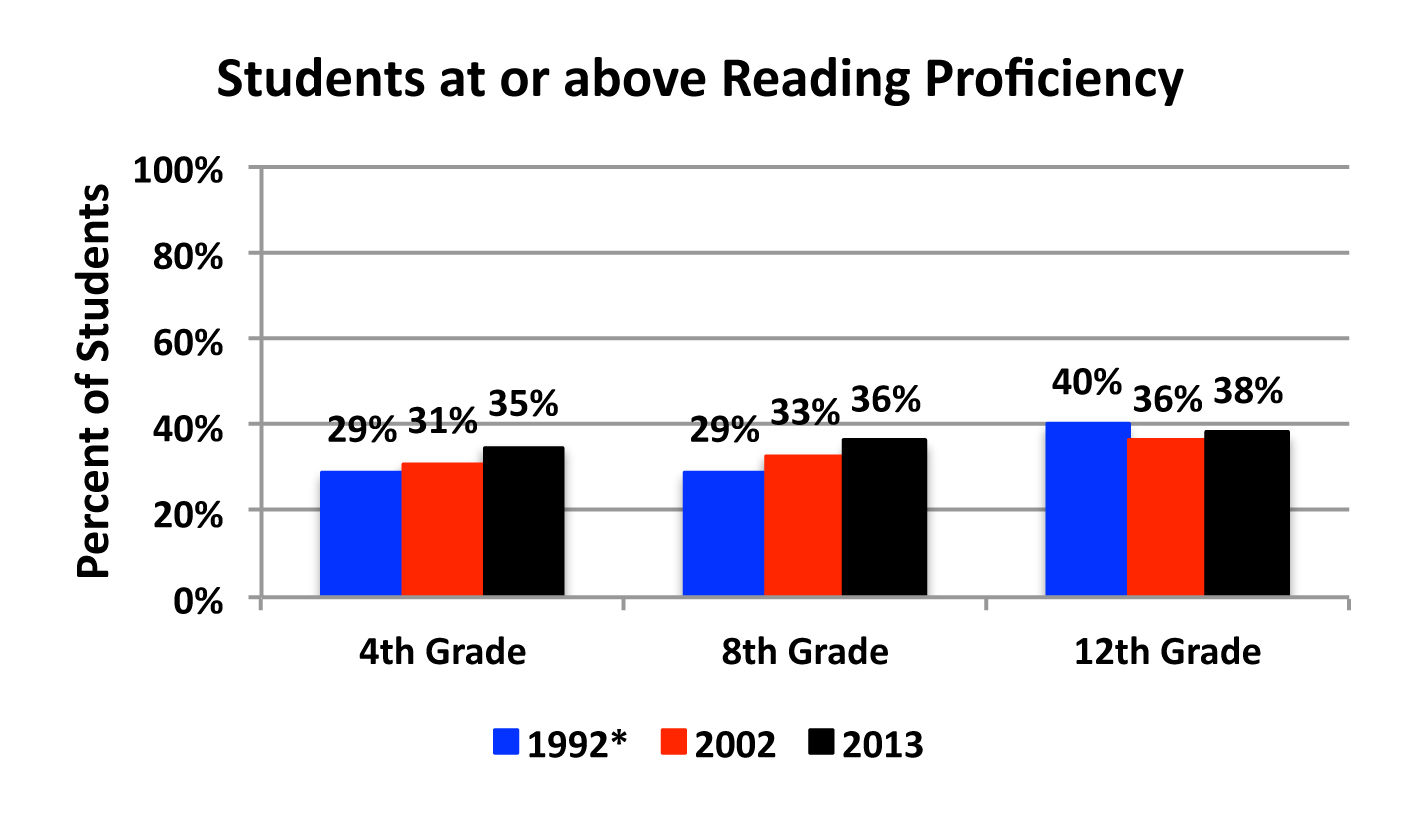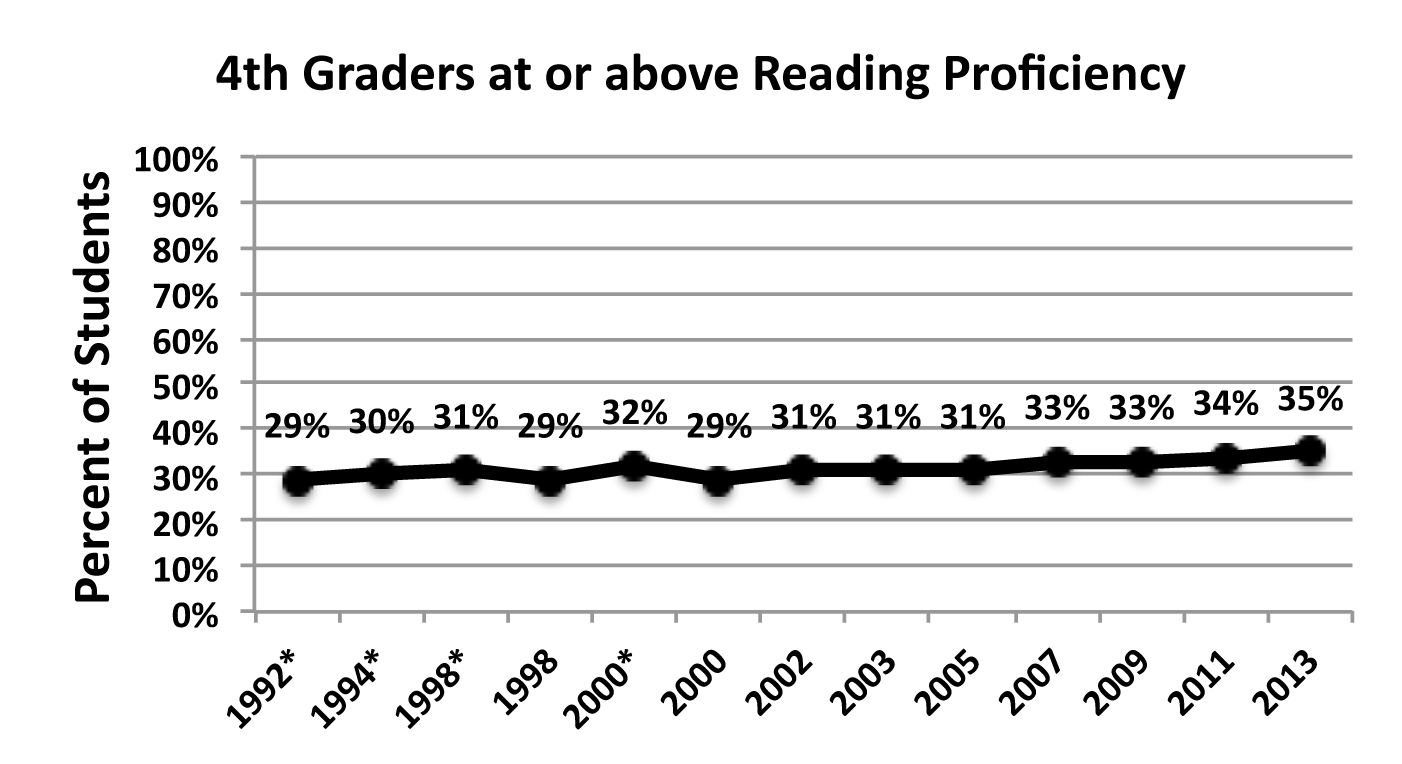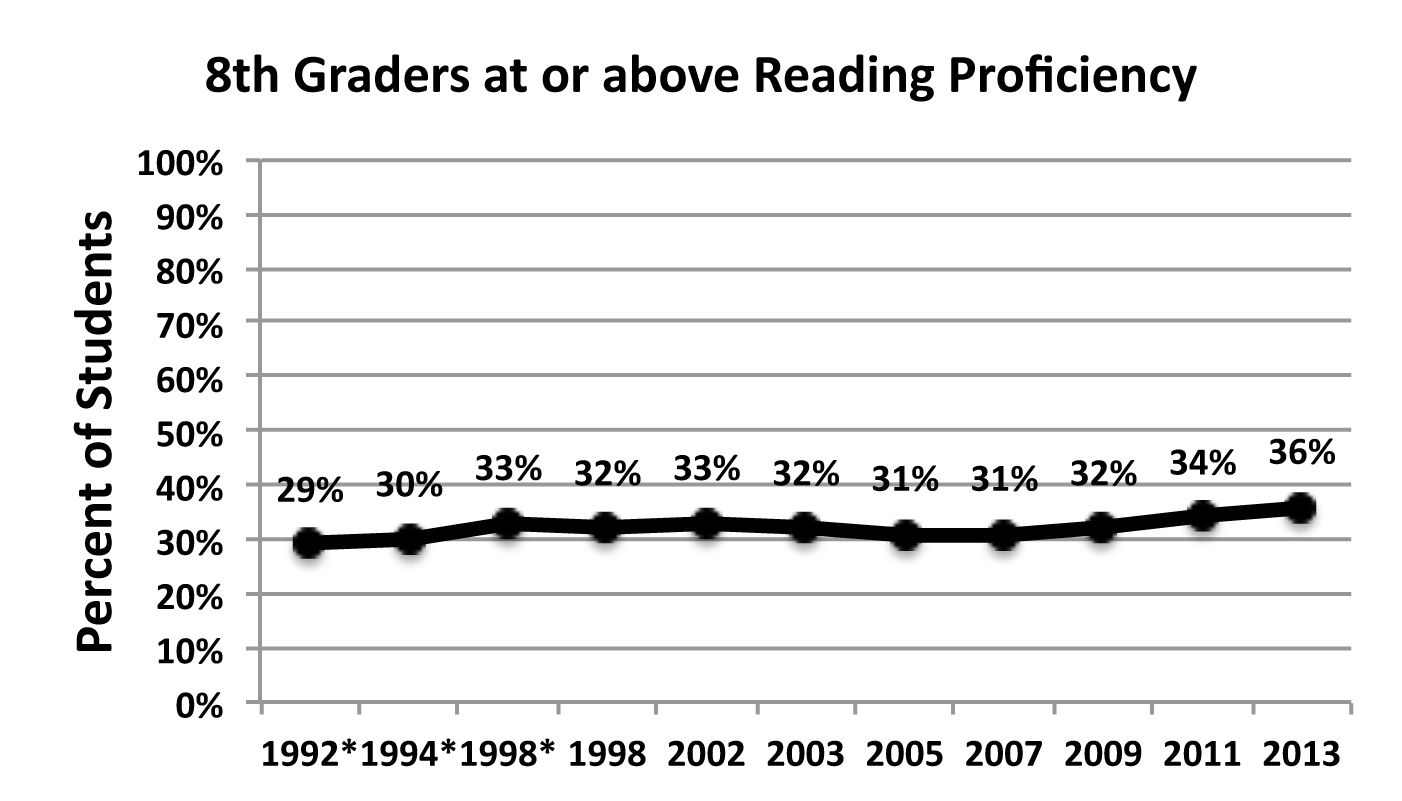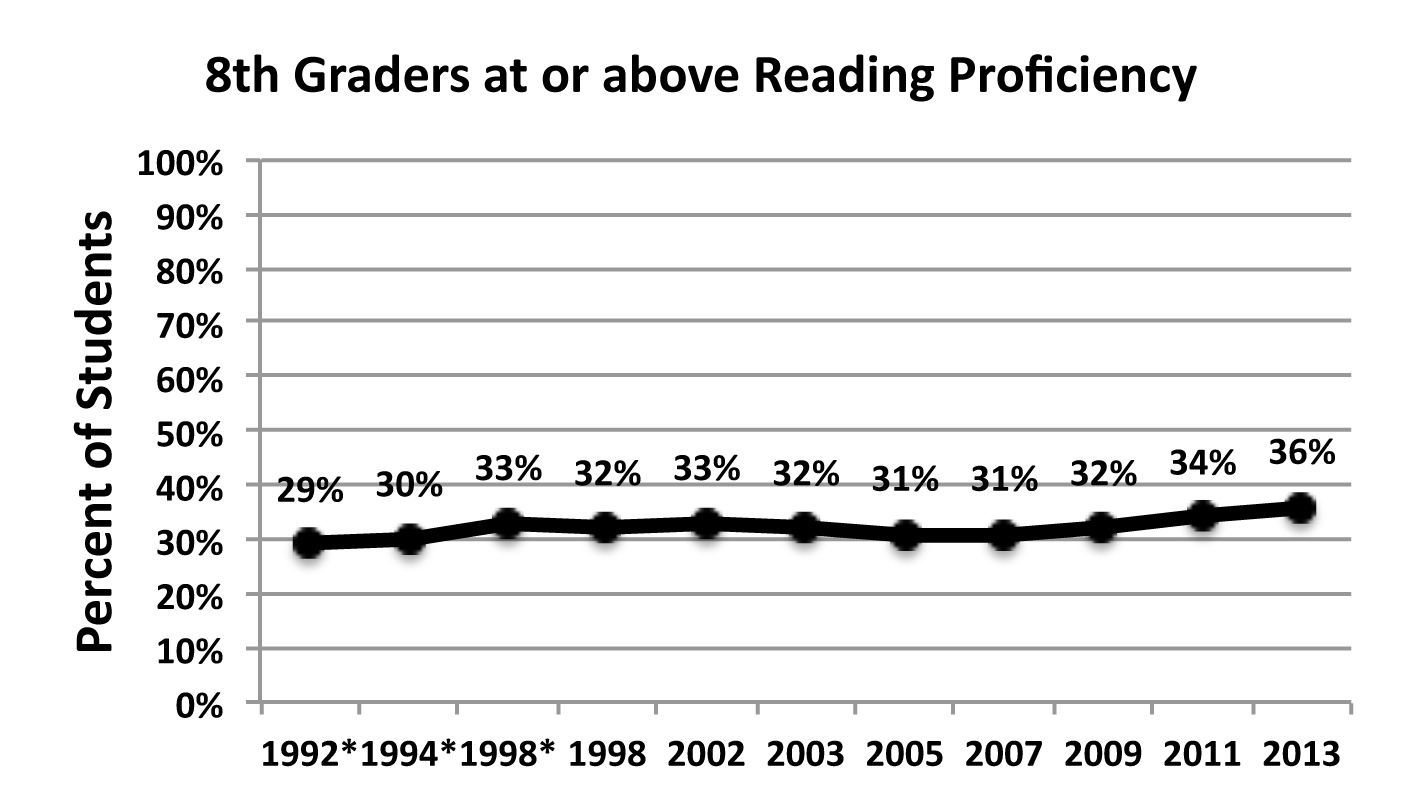Has student reading proficiency improved over the past 20+ years?
Why is this question important? A high-achieving education system must have in place processes to evaluate student performance regularly and over time. Additionally, it must have proficiency standards to identify skills that students should be able to demonstrate. Reading is one of the most important skills our education system teaches, and an enormous amount of time and energy has been invested over the past 22 years to improve student performance. Tracking performance over time allows stakeholders to gauge the overall success of American schools in teaching core curricula and to judge the impact of reform efforts.
To calibrate the National Assessment of Educational Progress (NAEP), the National Center for Education Statistics (NCES) secures recommendations from policymakers, educators, and members of the general public for specific achievement levels for each subject and grade. The following are benchmarks for student performance: Advanced represents superior performance, proficient represents solid academic performance, and basic denotes partial mastery of prerequisite knowledge and skills fundamental for proficient work at each grade. Proficiency becomes a critical benchmark because it is the level at which students have met the target standards for a subject area. (Gorman, 2010). It is also the benchmark by which No Child Left Behind (NCLB) holds school districts accountable (NCES, 2011c).
See further discussion below.

Figure 1: Percent of students at or above reading proficiency.
Source: The Nation's Report Card. A First Look: 2013 Mathematics and Reading.
Custom Data Table.
*Accommodations for students with disabilities were not permitted.
Results: he above graph displays reading proficiency scores for 4th, 8th, and 12th graders in 3 selected years: 1992, 2002, and 2013. The data for 4th and 8th graders show steady progress over the 21-year period, while 12th-grader performance did not improve. The most significant finding is that, regardless of any progress, in 2013 only slightly more than one third of all students (38% of 4th graders, 36% of 8th graders, and 38% of 12th graders) were reading at the targeted level of proficiency. An improvement of 6 percentage points over 21 years for 4th and 8th graders seems insignificant when current scores are so low, particularly given the significant resources invested in school reform during this period. The lack of progress is more evident when examining each grade's proficiency scores in detail.

Figure 2. Percent of 4th graders at or above reading proficiency.
Source: The Nation's Report Card. A First Look: 2013 Mathematics and Reading.
Custom Data Table.
*Accommodations for students with disabilities were not permitted.
The percentage of 4th graders reading at or above proficiency is improving at a snail's pace. NCLB—perhaps the most significant school reform initiative in this country's history—can be credited with an increase of just 4 percentage points over 11 years in 4th-grade reading proficiency. This is particularly problematic as research tells us that children who fall significantly behind in reading at an early age have a very small chance of making up the difference (OECD, 2012).
Figure 3. Percent of 8th graders at or above reading proficiency.
Source: The Nation's Report Card. A First Look: 2013 Mathematics and Reading.
Custom Data Table.
*Accommodations for students with disabilities were not permitted.
Data for 8th graders reading at or above proficiency follow the same pattern as for 4th graders. The importance of a 7 percentage point improvement since 1992 is significantly diminished given that, according to the most recent data, only 36% of students are at or above reading proficiency. Additionally, the improvement of only 4 percentage point since 1998 is extremely small.
Figure 4. Percent of 12th graders at or above reading proficiency.
Source: The Nation's Report Card. A First Look: 2013 Mathematics and Reading.
Custom Data Table.
*Accommodations for students with disabilities were not permitted.
The 12th grade reading proficiency data stand out for two reasons. First, there has been virtually no progress in proficiency scores over the past 22 years. Second, this represents the final data on how poorly our K–12 system has prepared students in reading. The fact that only 38% of graduating seniors in 2013 were proficient in reading is of great concern.
Implications: The value of a nation's education system is measured by how well it serves all of its children, not just those fortunate enough to attend a model school or live in a high-performing school district. While the NAEP achievement level assessment test is a macro-measure aggregating the performance of all students by age range, data from these tests provide a clear and unambiguous picture of how poorly the U.S. education system is educating students on selected content measures. The implications of these data must also be discussed at the macro level. The aggregate of all of the resources, initiatives, policies, and programs the United States has implemented for K–12 school reform has not had a corresponding impact on reading proficiency. A proficiency rate in the mid- to high 30% range is not an acceptable outcome for any education system.
Study Description: NAEP has often been called the gold standard for standardized academic testing because of its constant rigorous scrutiny (Gorman, 2010). Established in 1964, with the first tests administered in 1969, NAEP provides a continuing assessment of what American students know and can do in math, reading, science, writing, the arts, civics, economics, geography, and U.S. history. NAEP is administered by NCES, a division of the Institute of Education Sciences in the U.S. Department of Education. Panels of technical experts within NCES and other organizations continually scrutinize tests for reliability and validity, keeping them similar from year to year and documenting changes. NAEP is one of the few common metrics for all states, providing a picture of student academic progress over time.
The richest set of student achievement data come from NAEP, which provides data on subject matter achievement in two ways: scale scores (long-term trend assessment) and achievement levels (main NAEP assessment). The long-term trend assessment makes available test data in mathematics and reading going back to 1970, with test scores by age (9, 13, and 17). It is completed every 4 years. The main NAEP assessment reports test results on 12 different subject areas going back to 1992, with student data by grade (4, 8, and 12). It is completed every 2 years. For both assessments, probability samples of schools and students are selected to represent the diverse student population in the United States.
Citation:
Gardner, D. P., Larsen, Y. W., Baker, W. O., Campbell, A., Crosby, E. A., Foster, C. A., Jr., ...Wallace, R. (1983). A nation at risk: The imperative for educational reform. An open letter to the American people. A report to the nation and the secretary of education. Retrieved from http://www.eric.ed.gov/ERICWebPortal/detail?accno=ED226006.
Gorman, S. (2010). An introduction to NAEP. (NCES 2010-468). Washington, DC: National Center for Educational Statistics. Retrieved from http://nces.ed.gov/pubsearch/pubsinfo.asp?pubid=2010468.
National Center for Education Statistics (NCES). (2011c). The NAEP Glossary of Terms.
Retrieved from http://nces.ed.gov/nationsreportcard/glossary.asp#basic
National Center for Education Statistics (NCES). (2013). The nation's report card. A first look: 2013 mathematics and reading. Custom data table 4th grade reading. Retrieved from http://nces.ed.gov/nationsreportcard/naepdata/report.aspx?app=NDE&p=1-RED-2-20133%2c20113%2c20093%2c20073%2c20053%2c20033%2c20023%2c20003%2c20002%2c19983%2c19982%2c19942%2c19922-RRPCM-TOTAL-NT-ALC_BB%2cALC_AB%2cALC_AP%2cALC_AD-Y_J-0-0-37.
National Center for Education Statistics (NCES). (2013). The nation's report card. A first look: 2013 mathematics and reading. Custom data table 8th grade reading. Retrieved from http://nces.ed.gov/nationsreportcard/naepdata/report.aspx?app=NDE&p=2-RED-2-20133%2c20113%2c20093%2c20073%2c20053%2c20033%2c20023%2c20003%2c20002%2c19983%2c19982%2c19942%2c19922-RRPCM-TOTAL-NT-ALC_BB%2cALC_AB%2cALC_AP%2cALC_AD-Y_J-0-0-37.
National Center for Education Statistics (NCES). (2013). The nation's report card. A first look: 2013 mathematics and reading. Custom data table 12th grade reading. Retrieved from http://nces.ed.gov/nationsreportcard/naepdata/report.aspx?app=NDE&p=3-RED-2-20133%2c20093%2c20053%2c20023%2c19983%2c19982%2c19942%2c19922-RRPCM-TOTAL-NT-ALC_BB%2cALC_AB%2cALC_AP%2cALC_AD-Y_J-0-0-5.
Organisation for Economic Cooperation and Development (OECD). (2012). Education at a glance 2012: OECD indicators. OECD Publishing. doi:10.1787/eag-2012-en.


